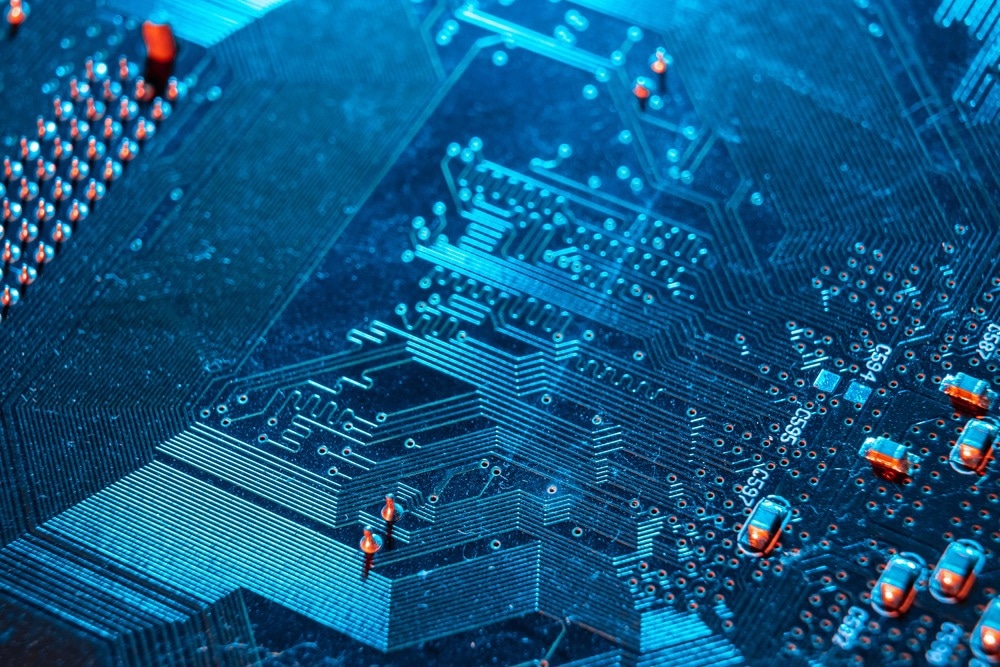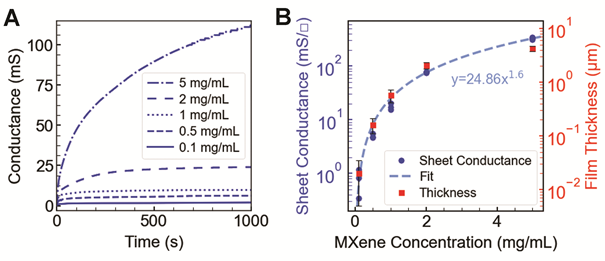An article accepted for publication in the journal Advanced Materials reports the production of liquid-only reconfigurable electronics using the self-assembly of two-dimensional titanium carbide MXene nanostructures.

Study: All-Liquid Reconfigurable Electronics Using Jammed MXene Interfaces. Image Credit: Marko Aliaksandr/Shutterstock.com
Solid-state components are the existing standard for electronic devices, but they possess limited post-production adaptability and create significant challenges for effective end-of-life disposal. All-liquid electronics may transcend these restrictions by providing flexible reconfiguration and segregation of electric components at the end of life through the use of simple liquid-phase chemistry.
Solid-state Electronics: Overview and Recyclability Challenges
Modern electronics depend almost entirely on solid-state parts, such as stiff thin-film capacitors, semiconductor detectors, metal wire interlinks, and transistors.
While these solid-state elements improve the integration potential of current electronic systems, they also bring new obstacles, such as diminished tunability and renewability. The extraction of limited supply minerals from electronic waste is a developing global problem.
The rigidity of solid-state electronics results in physical and temporal stability, yet this stability also serves as the primary detriment for the complete life-cycle reuse of these electronics. Although many recent studies using flexible polymer platforms provide application benefits such as wearable and adaptable electronics, they do nothing to tackle these reconfigurability or renewability issues.
Other techniques, such as composite materials or hydrogels, make use of strong interparticle forces and electrostatic attraction to provide remarkable tunability. However, the highly interconnected architecture of these devices can make it impossible to separate the elements at the end of life, significantly affecting material recycling.

Schematic of electrical measurements at a biphasic interface. In the 2-probe configuration (A), the organic ligand solution (yellow) is gently layered over the aqueous MXene dispersion (blue). After a short time, an interfacial film is self-assembled around the probes allowing electrical percolation through the film. In the 4-probe configuration (B), parallel plates are used to create a uniform flow of current that can be detected by the central voltage probes, allowing a determination of sheet conductance. A schematic (C) provides an idealized depiction of the initial experimental set up. Liquid toluene (yellow) containing butylamine ligands is deposited over water (blue) containing MXene nanoparticles. The conductive MXenes self-assemble at the interface and form a jammed, electrically-conductive sheet. The electrical properties are probed via gold electrodes that pierce the sheet. Due to the miscibility of butylamine in water, it is expected that some butylamine will diffuse into the aqueous phase over time, but we see no evidence that this affects the relatively robust structural or electrical properties of the jammed conducting sheet. Image Credit: Popple, D. et al., Advanced Materials
Importance and Limitations of Liquid-state Electronics
The development of all-liquid electrical devices and systems provides an appealing but mostly unexplored strategy for solving the aforementioned issues associated with solid-state electronics. Previous research on liquid-state electronics has concentrated on demonstrating circuits and basic pathways utilizing room-temperature liquid metals.
These techniques take advantage of the metallic characteristics of liquid metal alloys for effective electrical transmission and often encapsulate the devices in polymers to provide them with a usable form factor. While promising, such designs continue to use traditional solid-state electronics layouts that need a solid platform or enclosing medium to give shape to the device.
Moreover, room-temperature liquid metals are generally confined to gallium and indium alloys with several drawbacks. As a consequence, considerable effort is required to create alternative material solutions that allow electrical transmission while avoiding the constraints of solid platforms.
MXenes for Fabrication of All-liquid Reconfigurable Electronics
The creation of an electrically conducting interface built using nanoparticles that, when jammed, create a robust conductive matrix is fundamental to liquid-state electronic applications. MXene nanoparticles are suitable candidates for this purpose because of their high electrical conductance, wettability, and propensity to self-assemble at oil-water barriers in the vicinity of a ligand.
MXenes are a two-dimensional inorganic chemical group. These materials are made up of thin layers of transition metal nitrides, carbides, or carbonitrides. MXenes can integrate the metallic conductance of transition metal carbides with a hydrophilic character due to their hydroxyl- or oxygen-terminated interfaces.
In this study, the researchers built electronic components and circuits inside insulating liquids using MXene nanosheets functionalized with a butylamine ligand. Electrically conducting MXene nanosheets self-assemble and clog at liquid-liquid interfaces to form conducting channels. Butylamine ligands absorbed in toluene react with liquid MXene nanosheets and aggregate at the toluene-water interface.

Room temperature electrical conductance measurements of jammed MXene nanoparticles at a biphasic interface. A plot of conductance versus time (A) shows the equilibration of MXene films formed by various concentrations of the MXene dispersion. In this plot, ligands are added at time t=0, marking the beginning of the 15 minute equilibration. A plot of sheet conductance and film thickness versus MXene concentration (B) shows a saturation of both conductance and thickness at high MXene concentrations of 5 mg/mL. The dashed line is a fit of Eq. (1) to the conductance data (see main text). Image Credit: Popple, D. et al., Advanced Materials
Key Developments of the Current Research
The as-prepared liquid electronics combine the excellent conductance of MXene nanosheets with the programmable shape and adaptability of structured liquids. Even though MXene nanosheets were utilized as demonstrative materials in this study, the chemical composition of hierarchical liquid electronics is robust and can be adapted for different conducting materials.
Moreover, the flexibility inherent to the as-prepared liquid electronics enables the simple rebuilding of circuits rather than the fabrication of new hard circuits from scratch.

All-liquid non-volatile photodetector. (A) Plot of change in conductance versus time as equilibrated MXene wires are irradiated by a 432 nm laser for various durations. In this plot, laser exposure begins at t=0 and continues for 15, 30 or 60 s. This device serves as a non-volatile record of laser irradiation. The laser treatment can also be used to “dial in” a specified resistance for the MXene wire, thus reproducibly creating resistor components. The effect of the duration of laser exposure on the increase in conductance (B) shows that various exposure times can be used to tailor the resistance of the wire. Cartoon schematic (C) shows a possible scenario how laser irradiation displaces attached ligands, thereby bringing MXene sheets in closer proximity and permanently increasing the conductance of the printed wire. Image Credit: Popple, D. et al., Advanced Materials
Implementing this technique in consumer electronics would, admittedly, need additional technical solutions to address predicted endurance and longevity concerns. Some of these solutions include encapsulation, the inclusion of oxygen grabbers, and viscoelastic design. Nonetheless, the technique described in this paper sets the framework for the development of liquid electrical components.
Additionally, the capacity to electrify a junction or pipe while enabling chemicals to flow down the tube and across interfacial membranes may have uses in many microfluidic devices, particularly in situations where the products and substrates have a preference for different polarity solvents.
Reference
Popple, D. et al. (2022). Derek Popple; Mikhail Shekhirev; Chunhui Dai; Paul Kim; Katherine Xiaoxin Wang; Paul Ashby; Brett A. Helms; Yury Gogotsi; Thomas P. Russell; Alex Zettl. Advanced Materials. All-Liquid Reconfigurable Electronics Using Jammed MXene Interfaces Available at: https://doi.org/10.1002/adma.202208148
Disclaimer: The views expressed here are those of the author expressed in their private capacity and do not necessarily represent the views of AZoM.com Limited T/A AZoNetwork the owner and operator of this website. This disclaimer forms part of the Terms and conditions of use of this website.